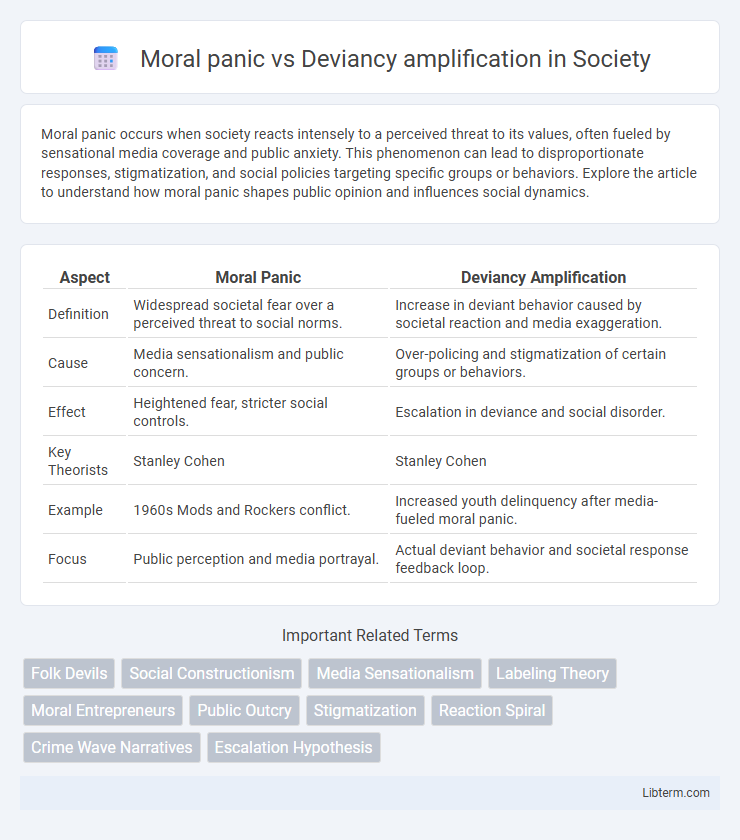Moral panic occurs when society reacts intensely to a perceived threat to its values, often fueled by sensational media coverage and public anxiety. This phenomenon can lead to disproportionate responses, stigmatization, and social policies targeting specific groups or behaviors. Explore the article to understand how moral panic shapes public opinion and influences social dynamics.
Table of Comparison
| Aspect | Moral Panic | Deviancy Amplification |
|---|---|---|
| Definition | Widespread societal fear over a perceived threat to social norms. | Increase in deviant behavior caused by societal reaction and media exaggeration. |
| Cause | Media sensationalism and public concern. | Over-policing and stigmatization of certain groups or behaviors. |
| Effect | Heightened fear, stricter social controls. | Escalation in deviance and social disorder. |
| Key Theorists | Stanley Cohen | Stanley Cohen |
| Example | 1960s Mods and Rockers conflict. | Increased youth delinquency after media-fueled moral panic. |
| Focus | Public perception and media portrayal. | Actual deviant behavior and societal response feedback loop. |
Introduction to Moral Panic and Deviancy Amplification
Moral panic refers to the widespread fear and exaggerated reaction by society or media towards a perceived threat to social norms, often targeting specific groups or behaviors. Deviancy amplification occurs when media coverage and societal responses to deviant behavior unintentionally escalate the behavior, increasing public concern and reinforcing negative stereotypes. Both concepts highlight the cyclical interaction between social reaction and deviance, where heightened awareness can lead to further marginalization and social control measures.
Defining Moral Panic: Origins and Key Features
Moral panic originates from sociologist Stanley Cohen's study of the 1960s Mods and Rockers conflict, characterized by exaggerated public fear and media exaggeration targeting a group perceived as a threat to societal norms. Key features include heightened public concern, hostility toward the scapegoated group, and disproportionate social or legal responses. This phenomenon mobilizes collective anxiety, often resulting in increased social control measures that reinforce existing power structures.
Exploring Deviancy Amplification: Core Concepts
Deviancy amplification involves a cyclical process where media and public reaction to deviant behavior intensifies the behavior itself, creating a feedback loop that escalates social concern. This concept highlights how heightened attention and moral condemnation can increase the visibility and occurrence of deviant acts, rather than suppressing them. Core features include media exaggeration, societal labeling, and law enforcement responses that collectively contribute to the amplification of deviance in communities.
Historical Examples of Moral Panic
Historical examples of moral panic include the Salem witch trials in the 1690s, where widespread fear of witchcraft led to mass hysteria and wrongful executions. The "Red Scare" periods in the United States during the 1920s and 1950s exemplify moral panic fueled by fears of communist infiltration, resulting in aggressive government actions and social stigmatization. These instances highlight how exaggerated public anxiety can escalate deviant behavior perception, sometimes triggering deviancy amplification through increased social control and media sensationalism.
Famous Cases of Deviancy Amplification
Famous cases of deviancy amplification include the Mods and Rockers clashes in 1960s Britain, where media sensationalism escalated minor skirmishes into widespread moral panic. Another notable example is the "Satanic Panic" of the 1980s in the United States, wherein exaggerated fears about ritual abuse led to false accusations and social hysteria. These cases demonstrate how societal reactions and media coverage can intensify fear and stigma surrounding particular groups or behaviors beyond their actual threat.
Media’s Role in Spreading Moral Panic
Media plays a crucial role in spreading moral panic by sensationalizing deviant behavior and exaggerating threats to societal norms, which amplifies public fear and concern. Continuous and biased reporting often distorts the reality of the situation, leading to deviancy amplification as both the public and authorities react disproportionately. This cycle strengthens negative stereotypes and stigmatizes specific groups, reinforcing social control measures and escalating social tensions.
The Impact of Social Control on Deviancy Amplification
Social control mechanisms often intensify deviancy amplification by reinforcing negative labels on certain groups, which can lead to increased deviant behavior as individuals internalize these stigmas. Media portrayals and law enforcement practices contribute significantly to this process by exaggerating the perceived threat, prompting stricter social controls that further marginalize the labeled individuals. Consequently, the cycle of social control and deviancy amplification perpetuates social exclusion and escalates the very behaviors it seeks to suppress.
Comparing Causes: Moral Panic vs Deviancy Amplification
Moral panic arises from exaggerated societal fears often fueled by media portrayal of a threat, while deviancy amplification stems from the social reaction that intensifies the deviant behavior it seeks to suppress. Causes of moral panic include moral entrepreneurs and sensationalist media framing, whereas deviancy amplification is driven by law enforcement actions and community responses that escalate deviance. Both processes involve feedback loops but differ fundamentally in originating from perception (moral panic) versus social response mechanisms (deviancy amplification).
Consequences for Society: Social and Legal Implications
Moral panic often leads to heightened societal fear, prompting swift legal actions that may disproportionately target marginalized groups, escalating social tensions. Deviancy amplification results in increased stigmatization and labeling of individuals or groups, reinforcing deviant behavior and perpetuating cycles of marginalization. Both phenomena contribute to restrictive laws and policies that can undermine social cohesion and exacerbate inequalities within communities.
Addressing Moral Panic and Deviancy Amplification in Modern Times
Addressing moral panic and deviancy amplification in modern times requires strategic media literacy education to reduce sensationalism and promote balanced reporting. Implementing community-based intervention programs can help dissolve stereotypes and prevent the exaggerated labeling of marginalized groups. Policymakers must focus on evidence-based approaches that prioritize social inclusion and accurate risk assessment to mitigate the cyclical effects of societal fear and deviance amplification.
Moral panic Infographic

 libterm.com
libterm.com